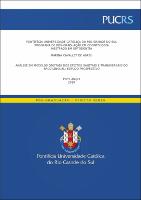| Share record |


|
Please use this identifier to cite or link to this item:
https://tede2.pucrs.br/tede2/handle/tede/8183| Document type: | Dissertação |
| Title: | Análise em modelos digitais dos efeitos sagitais e transversais do arco lingual : estudo prospectivo |
| Author: | Abreu, Marina Cavallet de  |
| Advisor: | Lima, Eduardo Martinelli Santayana de |
| Abstract (native): | O aparelho arco lingual é indicado para o tratamento na fase de dentição mista com o intuito de preservar o comprimento de arco em casos de perda precoce de dentes decíduos, impedindo a migração mesial do primeiro molar permanente. Embora a efetividade do uso do arco lingual seja universalmente aceita, o seu efeito na mudança da posição sagital e transversal dos molares e incisivos em pacientes em crescimento precisa ser melhor documentado. Objetivos: Avaliar em modelos digitais os efeitos do tratamento com arco lingual nos molares e incisivos permanentes em pacientes com diferentes tipos faciais. Materiais e Métodos: A amostra experimental consistiu em 38 pacientes (20 meninos, 18 meninas), com média de idade de 9 anos e 2 meses (variação, 7-12,2 anos). Para o grupo controle, foi selecionada uma amostra retrospectiva de 21 pacientes (11 meninos, 10 meninas), com média de idade de 9 anos e 4 meses (variação, 7,8 – 12,3 anos). Os pacientes foram classificados de acordo com o padrão de crescimento, para SN.GoGn ≤ 32º (Horizontais) e para SN.GoGn > 32º (Verticais). Um total de 118 modelos de estudo, foram escaneados (3Shape R700; Copenhagen, Denmark), e analisados no software OrthoAnalyzer (3Shape, Copenhagen, Denmark). O Teste t para amostras independentes foi utilizado para avaliar o grupo experimental e grupo controle. E o Teste t pareado, foi utilizado para a comparação entre os grupos. Resultados: No grupo arco lingual o comprimento de arco não apresentou variação estatisticamente significativa (p >0,05). Ocorreu aumento estatisticamente significativo da distância intermolares (p<0,001). Ocorreu inclinação para vestibular, estatisticamente significativa, dos incisivos inferiores (p < 0,001). O arco lingual foi mais efetivo na preservação do comprimento do arco para pacientes verticais (p< 0,001) e ocorreu inclinação vestibular dos incisivos inferiores estatisticamente significativa para esses pacientes (p < 0,001). Conclusões: O uso do arco lingual preservou o comprimento de arco, principalmente nos pacientes verticais, porém com maior potencial de inclinação vestibular dos incisivos inferiores nesses pacientes. O aparelho causou aumento significativo da distância intermolares, da inclinação vestibular de incisivos e molares inferiores. |
| Abstract (english): | In preventive and interceptive orthodontics, the use of mandibular fixed lingual arch is a commonly accepted procedure to maintain arch perimeter by preventing mesial tipping or drifting of the mandibular molars. Despite its widespread use, comparatively little is known concerning the efficiency of a lower lingual holding arch as a space holding device and its effect on the dimensions of the lower arch. Objectives: To quantify the arch dimensional changes that occur during the lingual arch use. Digital models were used to evaluate sagittal and transversal changes in the lower arch. Materials and Methods: The sample consisted of 38 patients (20 boys, 18 girls), with a mean age of 9.2 years (range, 7-12.2 years). For the control group, a retrospective sample of 21 patients (11 boys, 10 girls) with a mean age of 9.4 years (range, 7.8 - 12.3 years) was selected. Patients were classified according to growth pattern, for SN.GoGn ≤ 32º (Horizontal) and for SN.GoGn> 32º (Verticals). A total of 118 dental cats were scanned (3Shape R700, Copenhagen, Denmark). The OrthoAnalyzer software (3Shape, Copenhagen, Denmark) was used to evaluate the files. The independent t-test was used to evaluate the experimental group and control group. And the paired t-test was used for a comparison between groups. Results: In the lingual arch group, the arch length was not significant (p >0,05). The intermolar width significantly increase (p <0.001). Buccolingual inclination of the lower incisors was statistically significant (p <0.001). The lingual arch was more effective for preserving the arch length in vertical patients (p< 0,001) and buccolingual inclination of the lower incisors was statistically significant for these patients (p <0.001) Conclusions: The lingual arch is good appliance for preserving arch length, mainly in vertical patients, but with a potential for buccolingual inclination of the lower incisors. The intermolar width, and buccolingual inclination of the molars and lower incisors significantly increased. |
| Keywords: | Dentição Mista Arco Dental Mantenedor de Espaço em Ortodontia |
| CNPQ Knowledge Areas: | CIENCIAS DA SAUDE::ODONTOLOGIA |
| Language: | por |
| Country: | Brasil |
| Publisher: | Pontifícia Universidade Católica do Rio Grande do Sul |
| Institution Acronym: | PUCRS |
| Department: | Escola de Ciências da Saúde |
| Program: | Programa de Pós-Graduação em Odontologia |
| Access type: | Acesso Aberto |
| Fulltext access restriction: | Trabalho será publicado como artigo ou livro |
| Time to release fulltext: | 60 meses |
| Date to release fulltext: | 02/07/2023 |
| URI: | http://tede2.pucrs.br/tede2/handle/tede/8183 |
| Issue Date: | 24-Jan-2018 |
| Appears in Collections: | Programa de Pós-Graduação em Odontologia |
Files in This Item:
| File | Description | Size | Format | |
|---|---|---|---|---|
| DIS_MARINA_CAVALLET_DE_ABREU_COMPLETO.pdf | MARINA_CAVALLET_DE_ABREU_DIS | 3.17 MB | Adobe PDF |  Download/Open Preview |
Items in DSpace are protected by copyright, with all rights reserved, unless otherwise indicated.




